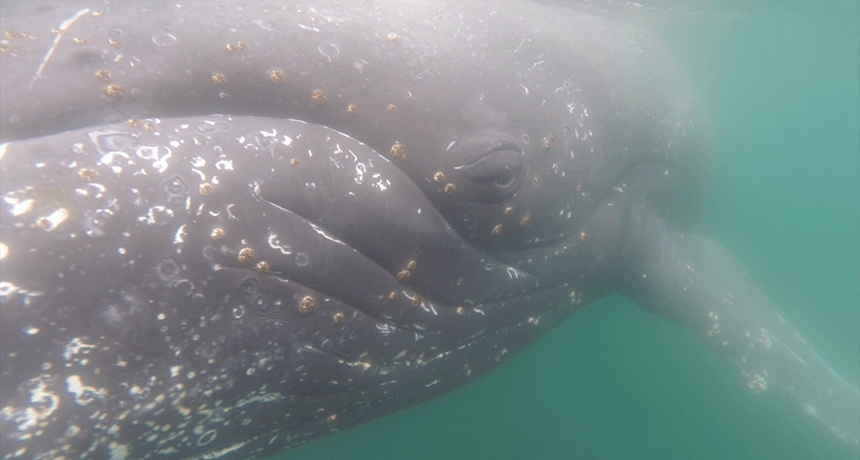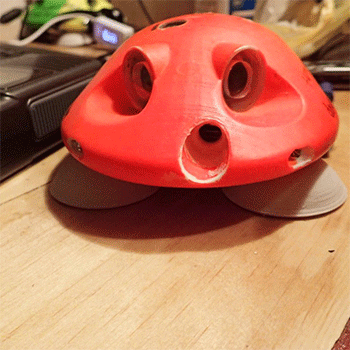Humpbacks flap their flippers like underwater birds
Researchers spotted whales making moves once thought impossible

Scientists filmed this humpback whale swimming with a large group of others as it fed off the coast of South Africa. The video shows the whale using its front flippers to move toward its prey.
Charles Littnan and Ari Friedlaender
Share this:
- Share via email (Opens in new window) Email
- Click to share on Facebook (Opens in new window) Facebook
- Click to share on X (Opens in new window) X
- Click to share on Pinterest (Opens in new window) Pinterest
- Click to share on Reddit (Opens in new window) Reddit
- Share to Google Classroom (Opens in new window) Google Classroom
- Click to print (Opens in new window) Print
Humpbacks use their front flippers in a way researchers had thought was impossible. New video reveals these whales flap their flippers like birds flap their wings. The move propels these giants toward their fishy prey.
A humpback can measure up to 19 meters (62 feet) long. Its flippers can extend another four meters (13 feet) in front of its body. It takes a lot of force to propel that big body forward. Scientists didn’t think the whales could flap their flippers fast enough to generate such force, says Paolo Segre. He’s a biologist at Stanford University in California who studies how animals move.
Segre led a team of researchers that captured video of humpbacks feeding off the coast of South Africa in November 2016. It showed the whales flapping their flippers the way birds flap their wings to move through the air (or through the water, for penguins).
Humpbacks mainly use those front flippers for steering, scientists had thought. Tails were what propelled them forward. Or so it seemed. But that guess wasn’t based on much. “Until recently, we had no idea what [the whales] were doing,” says Segre. “We just saw them when they popped up to breathe.”

That has changed with the creation of video-enhanced wildlife tagging. This technology uses sensors to measure a whale’s position, speed and acceleration. An attached video camera records the surrounding environment.
To attach a “tag,” researchers must steer a small boat as close to the animal as possible. Then someone leans over the edge with a 6-meter (20-foot) pole. On the end of it swings the tag. When close enough, a researcher slings the end to slap the tag onto the whale’s back. Suction cups should hold the device in place for 10 to 12 hours.
Later, the brightly-colored device will pop off. It then floats on the water until researchers collect it. Afterward, they will download the video and details about the whale’s movements.
Humpbacks appear to be special
The video camera records what’s happening around the tagged whale. From atop humpbacks in South African waters, the cameras recorded nearby whales as they hunted for fish. And it was then that the cameras caught the unusual propulsion technique.
Adult humpbacks can weigh more than 36,000 kilograms (40 tons). Because of their size, flapping probably takes a lot of energy, says Segre. He suspects the whales only use this tactic for short sprints to get close enough to slurp up fish.
And these whales are probably the only type that can do this, he adds. With shorter flippers, relative to their body size, other whales likely cannot generate nearly enough force to move forward by flipper flapping. The front flippers of humpbacks also are more mobile than those of any other whale. This lets humpbacks angle their flippers the right way to push them forward.
Segre and his team published their findings July 10 in Current Biology.
Flapping flippers for a burst of speed is probably a good strategy, notes Frank Fish. A biologist at West Chester University in Pennsylvania, he studies how whales move. As a humpback lowers its bottom jaw to catch prey, a throat pouch under its jaw fills like a parachute. This slows the whale.
But by using its flippers to help propel itself forward, the whale lowers the energy it will need to speed up again, says Fish.
“Think of driving a car and hitting the gas,” he says, “then hitting the brake to come to a stop and then hitting the gas again.” That repeated start-and-stop action wastes a lot of energy. Holding to a steadier speed tends to improve gas mileage. A humpback may do something similar with its flipper flapping. “By trying to maintain speed, this may reduce energy costs for the whale,” Fish suspects.
The whales’ ability to use flippers for propulsion might also help explain how some humpbacks can swim even after losing their tails in accidents, Fish says.
Stanford







